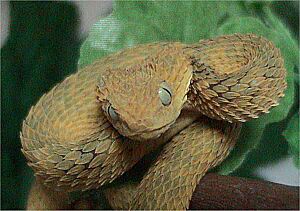Green bush viper facts for kids
Quick facts for kids Green bush viper |
|
|---|---|
 |
|
| Conservation status | |
| Scientific classification | |
| Genus: |
Atheris
|
| Species: |
squamigera
|
| Synonyms | |
|
|
The Variable Bush Viper (scientific name: Atheris squamigera) is a type of venomous snake. It is also known by names like the green bush viper or leaf viper. This snake lives only in certain parts of west and central Africa. It is known for its unique scales and bright colors.
Contents
What Does the Variable Bush Viper Look Like?
The Variable Bush Viper is a medium-sized snake. It usually grows to be about 46 to 60 centimeters (about 1.5 to 2 feet) long. Some can even grow longer than 78 centimeters (about 2.5 feet). Female snakes are usually bigger than males.
Head and Scales
This viper has a wide, flat head that stands out from its neck. Its mouth can open very wide. The head is covered with rough, overlapping scales. These scales make the snake look a bit spiky. Its nostrils are on the sides of its head.
The body scales are also special. In the middle of its body, it has 15 to 23 rows of scales. The scales on its belly are called ventral scales, and there are 152 to 175 of them. Under its tail, it has 45 to 67 scales.
Colors and Patterns
The Variable Bush Viper comes in many colors. Most are green, from light to dark, or even bluish or olive. Sometimes, you might find rare ones that are yellow, reddish, or gray. The scales often have light-colored ridges. These can form more than 30 light crossbands or V-shapes across its back. Its belly is usually yellow or dull olive. It might have black spots.
A cool feature is its tail tip. It's usually ivory white and about 7 to 12 millimeters long. Baby vipers are often dark olive with wavy patterns. They get their adult colors after about 3 to 4 months.
Where Do Variable Bush Vipers Live?
The Variable Bush Viper lives in the forests of West and Central Africa. You can find them from Ghana all the way to western Kenya and Tanzania. They also live south into northern Angola and on Bioko Island.
This snake is the most widespread species in its group, the Atheris genus. Scientists think that how these snakes are spread out today might be due to past climate changes and how Earth's land has moved over millions of years.
Their Home Environment
These vipers mostly live in rainforests. They prefer to hang out in low, thick bushes with lots of flowers. Their amazing camouflage helps them blend in perfectly with the leaves and branches.
Diet and Hunting Habits
The Variable Bush Viper mainly eats small mammals, like mice. Sometimes, they even eat other snakes of their own kind!
How They Hunt
This snake hunts at night. Its green color helps it hide among the leaves, making it a perfect ambush predator. It waits quietly for its prey to come close. When it attacks, it uses two hollow fangs at the front of its mouth. Through these fangs, it injects a special kind of venom. This venom affects the blood of its prey, making them helpless.
Reproduction and Life Cycle
In the wild, Variable Bush Vipers start having babies when they are old enough. Females are ready at about 42 months (3.5 years), and males at 24 months (2 years). They usually reproduce once a year, often during the rainy season.
Giving Birth
A. squamigera snakes give birth to live young, meaning the babies grow inside the mother. The mother carries her babies for about two months. A single mother can have up to 19 babies, but usually, it's about 7 to 9. After birth, the baby snakes are left on their own. They are born with venom and can take care of themselves right away.
Common Names for the Variable Bush Viper
This snake has many common names. Some of them are:
- Green bush viper
- Variable bush viper
- Leaf viper
- Common bush viper
- Tree viper
- Hallowell's green tree viper
- Yété (in the Mongo language)
Venom Information
Bites from the Variable Bush Viper can be serious. There have been reports of severe blood problems and even deaths from their bites. While there isn't a specific antivenom made just for Atheris snakes, antivenom for the Echis genus (another type of viper) has been shown to help against Atheris venom.
Images for kids



